ISSN ONLINE(2278-8875) PRINT (2320-3765)
ISSN ONLINE(2278-8875) PRINT (2320-3765)
F.A. Althowibi1,M.W. Mustafa2
|
| Related article at Pubmed, Scholar Google |
Visit for more related articles at International Journal of Advanced Research in Electrical, Electronics and Instrumentation Engineering
Voltage collapse has been recognized as a series threat in power system stability and operation. Fast and accurate indications and allocations of voltage stability in power systems are a challenging task to accomplish. Voltage violations and undesirable line outages might be inevitable when power systems operated close to its transmission capacity limits. Unexpected load increases or insufficient reactive power supply may contribute to partial or total voltage collapse threatening system security. The ability to draw a clear and complete picture of system voltage stability with accurate indications and precise voltage collapse allocations allow operators to take the necessary action to prevent such incidents. A successful avoidance of such system collapse is based on method’s accuracy, speed of indication, and very low computation time. This paper presents a new approach of studying voltage stability in power systems at which voltage stability in transmission lines and system buses are carefully analysed based on their V-Q and V-P relationships. Four indices are proposed; two for voltage stability analysis at system buses designated as VPIbus and VQIbus studying the dynamics of loads and generators while VPILine and VQILine are for line voltage stability analysis studying transmission lines stress and outages. Voltage collapse is precisely predicted by the proposed indices for the system as a whole and for every bus and line. These developed indices are simple, fast, and accurate proving a clear and complete picture of power flow dynamics indicating maximum active and reactive power transfers through transmission systems. The proposed approach was demonstrated on the IEEE 14-bus and 118-bus systems and compared with existing methods to show its effectiveness and efficiency.
Keywords |
| Voltage collapse, Line voltage stability index, Voltage stability analysis |
I. INTRODUCTION |
| The growth of power systems have been witnessed worldwide by engineers, utilities and customers. As energy demands is increasing rapidly, power system is expanding to accommodate the rapid load growths by constructing new power plants, transmission lines, substations, and control devices. The shape of electric power industry also has been changed and persistently pressured by government agencies, large industries, and investors to privatize, restructure, and deregulate [1]. This continues expansion and persistent pressure make power system more complex or may be vulnerable and difficult to maintain its stability and ensure its security. |
| As a result, several blackouts directly related to voltage collapse have been occurred costing lots of million dollars, and still a threat to power system stability and security. Some well-known incidents of blackout recorded in Germany in 2006 and Russia in 2005[2-4], in Greece 2004 [5, 6], Italy in 2003[2] and in the same year, blackouts occurred in USA and Canada[7], Sweden-East Denmark[2], London, UK[8] and Croatia and Bosnia Herzegovina[9]. |
| Voltage collapse is most likely to occur when a power system is operated near its capacity limits. Some electric utilities are forced at such level due to the difficulty of constructing a new transmission line because of the new regulations and policy, or to reduce their operational costs and maximize their profits, but doing so raises risks that make it challenge for operators to contain or control. |
| Operating within operational design limits makes power system more protected and secure, yet operating beyond those limits can lead to the absence of generator synchronism, transmission outages or might result in partial or total system voltage collapse. Hence, maintaining voltage stability in power networks plays a significant role in preventing voltage collapse. |
| Voltage stability is well-defined and classified in [10] while addressing an appropriate analysis for voltage stability phenomena among engineering and researches are still debatable. Voltage stability has been studied using two main approaches: static and dynamic analysis, where voltage instability as fact is considered as dynamic phenomenon. Although the dynamic analysis is preferable by most utilities, the static voltage stability approach is commonly used in research and on-line applications providing an insight into stability problems with high speed analysis. |
| Several methods have been used for static voltage stability analysis to measure voltage stability proximity estimating the point of voltage collapse. A number of methods proposed in the literature use the singularity of power flow Jacobian matrix as base, sing or indicator of voltage collapse. Several methods are developed using eigenvalue or Jacobian matrix singularity monitoring the smallest eigenvalue[11-14], are based on a reducing Jacobian determinants[15, 16], identifying the critical buses using a tangent vector [17], or computing eigenvalues and eigenvectors of a reduced Jacobian matrix as introduced in[11, 18] and named as modal analysis. Other methods took another approach determining maximum loadability at line [19-23] while others are specifying system stability margins at bus attempting to determine the weaken bus [24-27]. |
| Recently, voltage collapse prediction index (VCPI) has been introduced in [28] to evaluate voltage stability and predict voltage collapse while an improved voltage stability index designated as Lij has been described in [29] taken into account the influence of the load model. |
| A combination of voltage stability static and dynamic approaches was introduced in [30] named as PTSI and used to study power system dynamic and behaviour and to predict voltage collapse point. Similar approach was developed in [31] evaluating voltage stability when a small disturbance is applied. |
| P-V curves introduced in [32] using only one power flow solution instead of multiple solutions to estimate voltage collapse point while another indices based on voltage stability margins presented in[33, 34]. Similarly, two sensitive indices with deviation approach developed in [35] used to monitor the available voltage stability margin to the collapse point terms as TRGGP and TRGGQ. |
| Other researchers took a different approach to study voltage stability problem using a non-iterative technique based on Taylor’s expansion [36], using an equivalent local network model in[37], or considering a distribution network with high/medium [38] to evaluate voltage stability and determine system voltage collapse point. |
| Method diversity in applications, conditions, purposes, and usability is vulnerability in voltage stability analysis. Some of these methods are robust or accurate, but might consume more time particularly in large power systems while others tend to fail if any power system element such control devices is involved. Some of these models are also just applicable for specified applications or certain conditions which might be inappropriate to be used in general. Other methods such on-line monitoring methods dispread to have real-time data to determine the proper corrective strategies in insecure conditions while other approaches such load modelling are not practical when every load should be modelled accurately. |
| Because of above these shortcomings, research in this area is needed. Readability and clear indications, speediness and lower computation consumption, result accuracy, correct indications and precise allocations of voltage stability, and simplicity rather than complexity are the keys of preventing voltage instability and avoiding voltage collapse event. If such indices are developed, system blackouts can be avoidable. |
| This paper presents a new approach of conducting voltage stability analysis, where transmission lines and power system buses are both analysed based on V-P and V-Q associations providing a clear and complete picture of system dynamics. Four indices are proposed; two for voltage stability analysis at system buses designated as VPIbus and VQIbus studying the load and generator dynamics while VPILine and VQILine are for line voltage stability analysis studying transmission lines stress and outages. VPIbus and VQIbusgenerate indications of voltage stability for each power system bus while VPILine and VQILineproduce voltage stability indications at each individual line. VPIbus ,VQIbus, VPILine and VQILineine predict accurately the point of voltage collapse for the system as a whole and also for every bus and line indicating powerful tools in conducting voltage stability analysis. |
| The proposed indices are simple, accurate and fast generating voltage stability indications with low computation time needed to avoid such voltage collapse events. The introduced indices can be applied in real-time application producing quick voltage stability indications, allowing controls to take necessary action to prevent such incidents. The proposed indices might fulfil the needs of electric sectors and meet application’s requirements to prevent future blackout incidents. This method has been demonstrated on the IEEE 14-bus and 118-bus Test Systems to show its effectiveness and efficiency. |
II. THE PROPOSED INDICES |
| The paper proposed two indices of conducting voltage stability analysis based on bus and line power system. The first index is named as VPI where voltage profiles and maximum power transfer in power systems is related while the relationship between voltages and load reactive powers are established in the second index termed as VQI. Both indices,VPIandVQI, are able to conduct voltage stability based on bus system designated as VPIbusandVQIbus studying the dynamics of load-generation powers at bus while VPILineandVQILine curry out line voltage stability analysis studying line stress conditions and outages. |
| A. Voltage Stability Analysis at system buses: |
| The system shown in, Fig.1 is representative of general power system and the transmission line is connecting a generator with load. The network is presented by an equivalent generator modelled in steady state and it is assumed that the generator voltage, E, is in normal condition and equal to the voltage at generation bus Vi. Vi will be kept constant using generator excitation systems. |
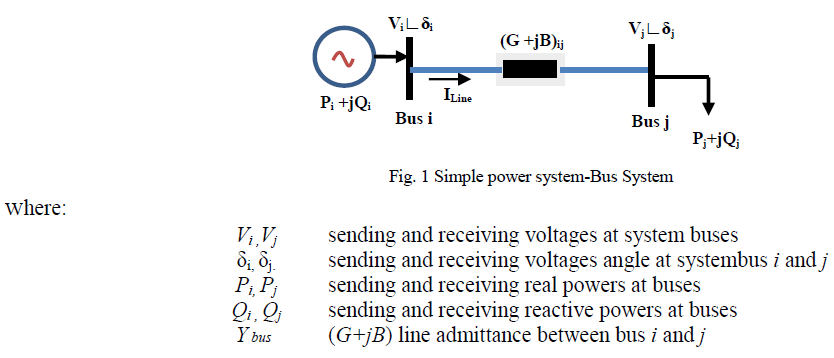 |
| This general system can be extended to an n-bus power system used to establish a relationship between the sending voltage,Vi, and the receiving real powers, Pj at bus. This gives an accurate estimate of voltage stability margin with real power at the specified or critical bus indicating the maximum MW that can be transferred via transmission systems. |
| Let’s assume bus i is as a reference bus, then, the line current, I, is calculated by: |
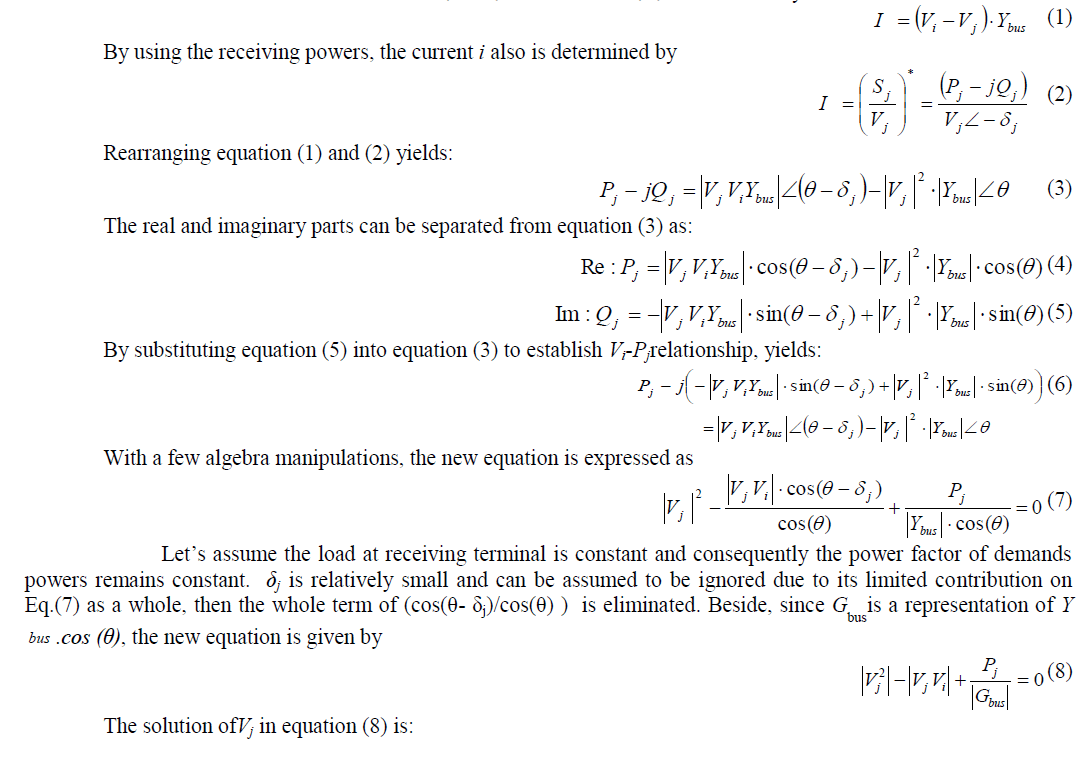 |
 |
| The Vj varies from zero to one producing several indications due to the real root limitation. This limitation can be usedas voltage stability indicator, where real root voltage is greater than zero and lower than one. If not, the voltage stability is compromised. This proves that the developed equation determines voltage stability at bussystem and be termed as |
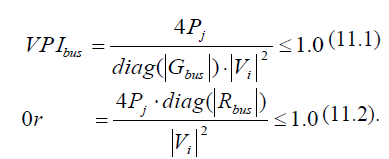 |
| Fig.1 is also used here to establish a relationship between the sending-end voltage,Vi, and the receivingendreactive powers, Qj. It perhaps may give more accurate voltage stability analysis. Reactive power is closely associated with system voltage security giving an accurate estimate of voltage stability margin with reactive power at the specified or critical bus. The reactive power margin is the MVAr distance starting from the normal operation point and ending by the point of voltage collapse. |
| By substituting equation (4) into equation (3), the V-Q relationship is establishedas |
 |
| With a few algebra manipulations, the new equation is expressed as |
 |
| By using the same assumptions and following the same procedures, the discriminated Vj root in relationship with load reactive powers is expressed as |
 |
| As Bbus has dominant diagonal elements; the VQI can be expressed as |
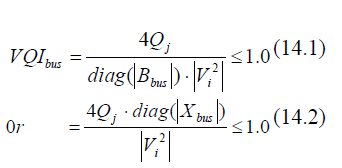 |
| VPIbus and VQIbus vary from zero to one indicating system stability boundaries. When the values of VPIbus and VQIbus close or near to the unity, the voltage stability reaches stability limits. Voltage collapse occurs when both VPIbus and VQIbusareexceeding their stability limits. |
| B. Line Voltage Stability Analysis: |
| The number lines in power systems are usually higher than the number of buses as to assure power delivery to main load centres and to improve system reliability and stability ensuring its security. Due to heavy loaded or stressed system lines, transmission line is more likely to be collapsed or outage and mayeventually contribute to partial or total system collapse. Studying the maximum transfer of real and active powers that each transmission line can handle before its outage or collapse is essential. |
| Because transmission lines are connecting buses in power systems, the same assumption should be applied in this developed theory, which is the generator voltage, E, is equal to the voltage at generation bus Vi.Vi will be kept constant using generator excitation systems. |
| The system shown in, Fig.2 is a simple line power system connecting the sending bus by the receiving bus through transmission line. This simple line system can be extended to an n-line power system. |
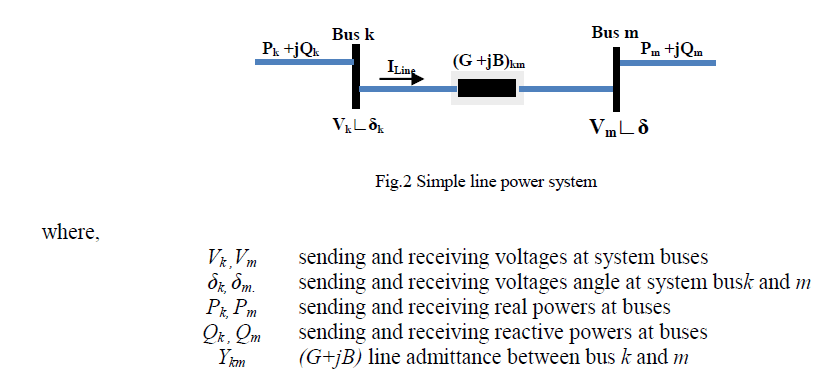 |
| Here, the sending-end voltage profiles, Vk,,and receiving-end powers,Pm, relationship at system line is established. Let’stake bus k as a slack bus, then, the line current, I, is: |
| By using the receiving-end apparent powers, the current between sending-end bus and receiving-end bus,I,obtainedby: |
 |
| Rearranging equation (15) and (16) yields: |
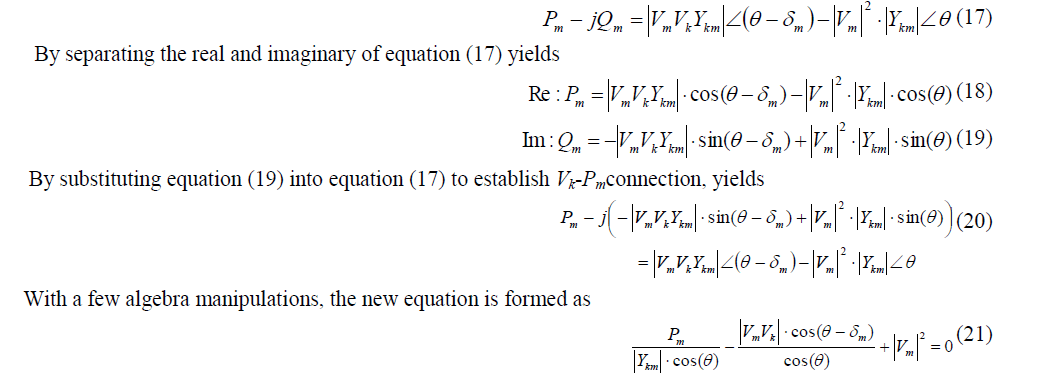 |
| Let’s assume the load at receiving-end terminal is constant and consequently the power factor of demand powers remains constant. Beside, some of receiving-end powers are generators acted as negative sources and their voltage profiles are already assumed to be reserved constant. Thus,δm is relatively small and can be ignored due to its limited contribution on Eq.(21) . Then, the new equation is expressed as |
 |
| If Vm is discriminated to zero, the real roots of Vmisobtained by |
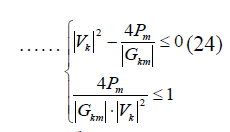 |
| The Vm varies from zero to the unity and can be fit for line voltage stability indicator expressed as |
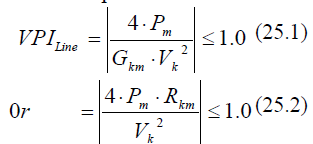 |
| The sending-end voltages, Vk, and receiving-end reactive powers, Qm, are also can be connected in line power system. By using Fig.2 and the same assumptions mentioned earlier, the connection between Vk-Qm can be derived from equations (17) to (19) by substituting equation (18) into equation (17) andyields, |
 |
| By arraigning equation (26) with a few algebra manipulations, the new equation is expressed as |
 |
| By using the same assumptions of neglectingδmand following the same procedures, the discriminated Vm root in relationship with load reactive powers is expressed as |
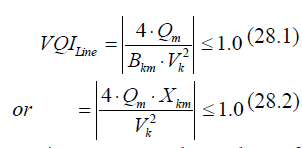 |
| VPILineandVQILinevary from zero to one presenting line voltage stability margins. Once the value of VPILineandVQILineapproach unity, the voltage stability reaches stability limits. The occurrence of voltage collapseis taken place once VPILineandVQILineexceedingtheir stability limits. VPILineandVQILinedetermine how far the transmission line is from its instability or collapse point. |
III. REVIEW OF VOLTAGE STABILITY METHODS: |
| Three voltage stability methods arebriefly discussed in this sectionwhich are: Modal analysis introduced in [77, 90, 91], voltage collapse prediction index at bus (VCPI) [17], andLine stability index (Lmn) [13]. |
| A Modal Analysis |
| Modal analysis is analytical tools used to determine system stability margins and network limits. It computesthe eigenvalues and eigenvectors of a reduced power flow Jacobian matrix, where the eigenvalue defines stability modes and themagnitude of eigenvectors approximate system voltage instability. The equations of power floware expressed in matrix format as |
 |
| where |
| ΔP and ΔQ the changes in the real and reactive powers |
| ΔV andΔδ the deviations in bus voltage magnitude and angle |
| Once assumed ΔP=0in Eq.(29), the V-Q sensitivity is established and expressed as |
 |
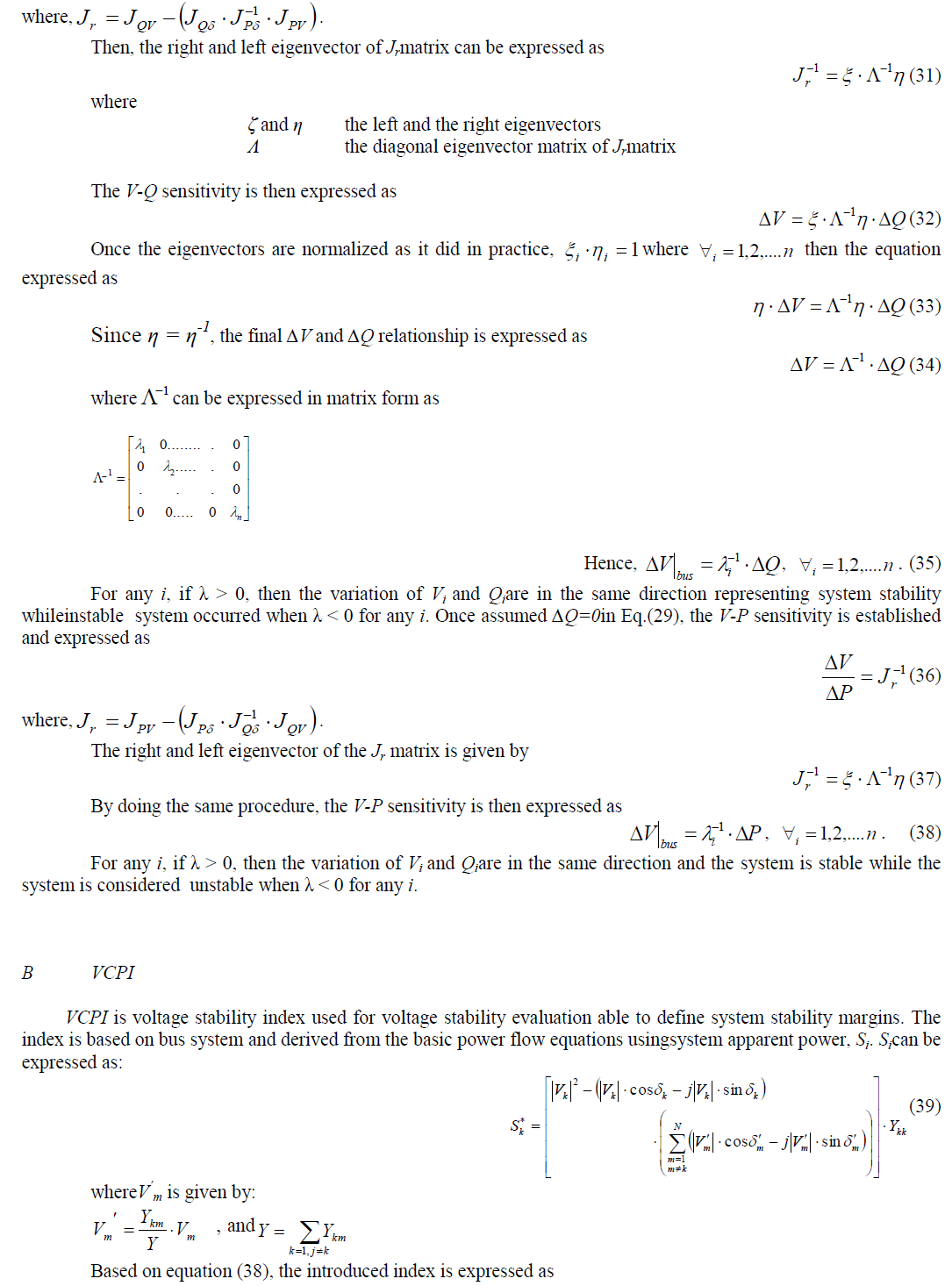 |
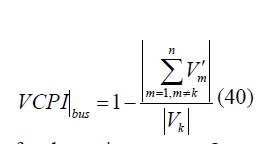 |
| VCPI varies from zero to one and its limitation specifies voltage stability margins for the entire system. Once the value of VCPIis nearthe unity or exceeding it, the system voltage stability is comprised and the voltage collapse is more likely to occur. |
| C Lmn |
| Lmn is a new voltage stability approach used to calculate line voltage stability attempting to detect the stress and condition of power system lines and predict line voltage collapse. Using a single power system line model as shown in Fig.2, the line quadratic voltage is calculated by |
 |
| where the real root of receiving voltage generates more values between zero and one and its boundaries representing line system stability, used as an index named as Lmn and expressed as |
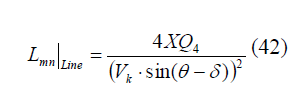 |
IV. RESULTS AND DISCUSSION |
| This section is a demonstration of the proposed indices,VPIbus, VQIbus,VPILine andVQILine, on IEEE 14-bus and 118-bus systems to carry out line and bus voltage stability analysis. The proposed bus indices were compared first with receiving-end voltages to check V-P and V-Q associations, and then compared to VCPI and Modal analysis (dV/dP and dV/dQ) at bus system to measureVPIbus’s andVQILine’s relative effectiveness and efficiency. The proposed line indices wereafterward compared with Lmn first to verify their accuracy in conducting line voltage stability analysis (because they have similar characteristics) and then to VCPI and Modal analysis to validate their accuracy of voltage collapse predictions. |
| VCPI and Modal analysis ( dV/dP anddV/dQ) are used for bus voltage collapse predictions; where VCPI is suggested for online voltage stability evaluation and Modal analysisisproposed to compute the eigenvalues and eigenvectors of power flow Jacobian matrix to estimate voltage dynamic collapse. These mentioned methods are different and have different characteristics, yet they all share voltage stability margins estimating one system collapse event or point. Few loading scenarios were considered in this study where each loading scenario was increased gradually till the system collapsed. |
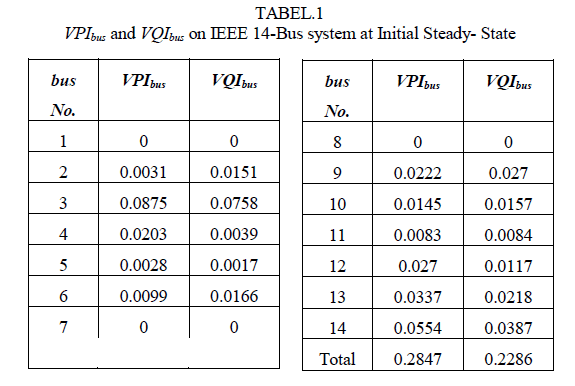 |
| A. IEEE 14-bus system: |
| 1. Initial state scenario at bus: |
| Table.1 showed theVPIbusandVQIbus performances on IEEE 14-bus system, where both conducted bus voltage stability analysis at system steady-state condition. The results presented that VPIbusandVQIbus successfully indicated voltage stability at each individual system bus recoding 0.2847 and 0.2286 at zero loading rate kfor the summation of VPIbus and VQIbus respectively. There was no voltage stability indication at a reference bus and nor voltage stability results when there were no records of load powers as indicated at bus 7 and 8. |
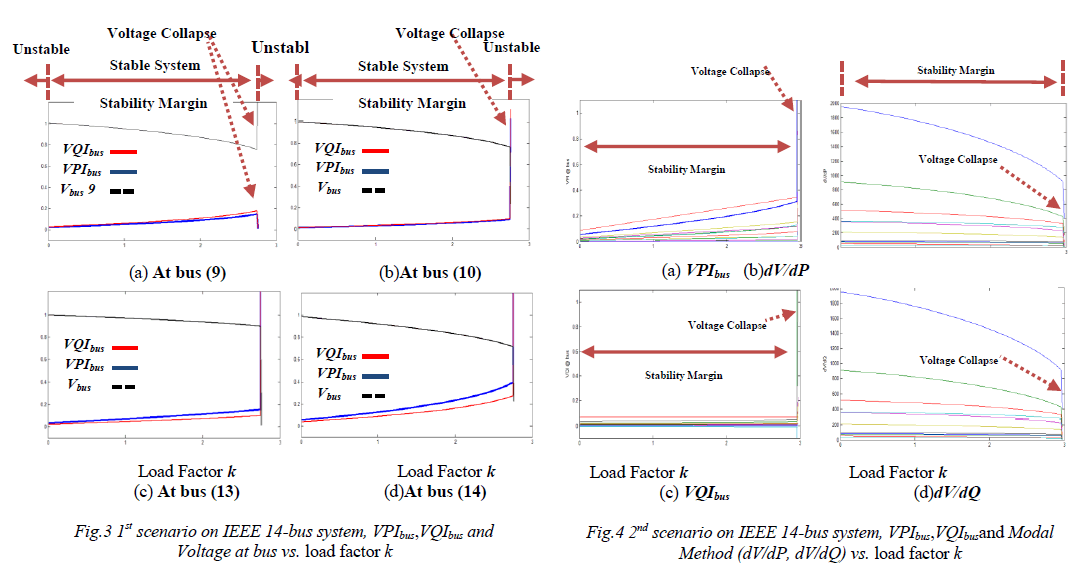 |
| 2. Loading scenario at bus: |
| In this application, the loads were remained constant and increased in small steps, 0.01 units, until the IEEE 14-bus system collapsed. At this point, the voltage collapse is predicted and voltage stability margin is calculated. Two load scenarios were considered in this study. There were two loading scenarios: load components were increasedat all buses once with identical k until the system collapsed while the real load components were increasedsimultaneously at all bus with identical k until reached to a point, where the system voltage collapse occurred. The power factors were kept constantpresumably. |
| Figure 3 illustrates the first loading scenario where the loads were incrementally increased at all buses until the IEEE14-bus system collapsed. Here, four buses were selected randomly (9, 10, 13 and 14) in which the proposed bus indices were compared against the receiving-end voltage,Vbus. The results showed that both VPIbus andVQIbusindices predicted the point of voltage collapse at loading rate k = 2.75 intercepting with the receiving-end voltage,Vbus indicating an accurate projection of voltage collapse at that particular buses. At the point of collapse, the both VPIbus andVQIbus passed their unity exceeding their stability while Vbus dropped sharply approaching zero. From subfigure (3.a), as loading rate k increased at bus (9), VPIbus andVQIbusincreased until reached to a point, where both indices went sharply to zero passing its stability limits and Vbus rose sharply going to infinity. Maximum real and active power transfers were also estimated by VPIbus andVQIbusfor each individual bus starting by the system initial state and ending by the point of voltage collapse. |
| Figure 4 illustrates the second loading scenario where the load real powers only were simultaneously increased at all buses until the 14-bus system collapsed. VPIbus and VQIbus compared to modal analysis (dV/dP and dV/dQ) to verify their accuracy of estimating voltage collapse point. In each of these subfigures, VPIbus and VQIbus are shown in sub-figures (a) and (c), while modal analysis-dV/dP and dV/dQ are shown in subfigures (b) and (d) respectively. |
| All indices started together in normal system condition and collapsed at loading rate k= 2.96 showing that they had an identical voltage collapse point as they had the same system stability margin. At loading rate k= 2.96,VPIbus |
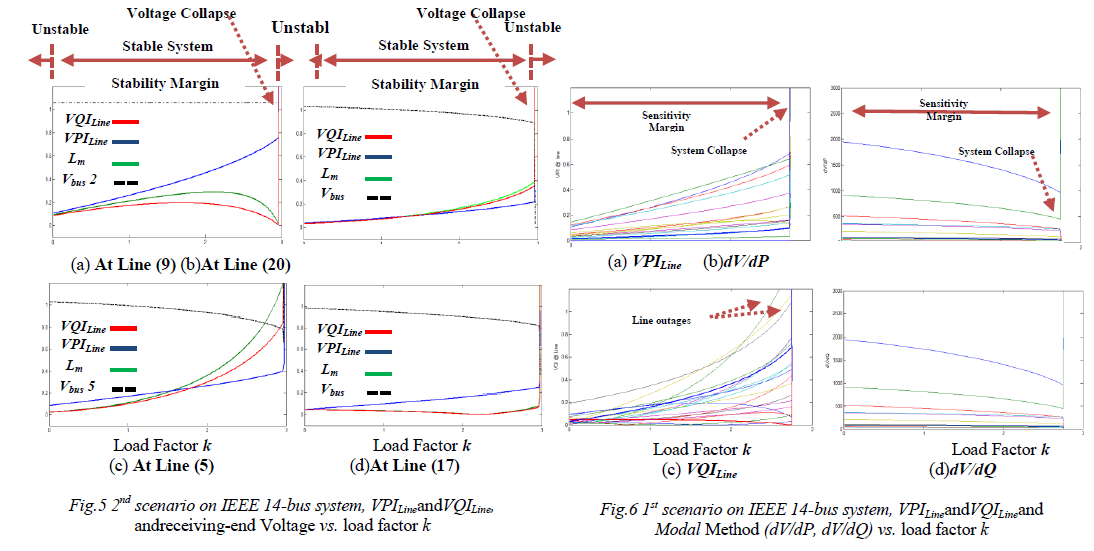 |
| andVQIbus went sharply passing their unity and exceeding their stability limits while dV/dP and dV/dQ dropped gradually to zero, where their matrixes approached singularity. |
| As seen in subfigures (4.a) and (4.c), VPIbus andVQIbusindicated voltage stability for the system as a whole and for every bus providing maximum real and active powers that every buswas able to deliver while dV/dP and dV/dQ gave a clear voltage collapse prediction as shown in subfigures (4.b) and (4.d) respectively. |
| 3. Initial state scenario at line system: |
| Table.2 showed the VPILineand VQILine performances on IEEE (14-bus, 20 lines) system, where both were carried out line voltage stability analysis at system normal condition. The result outcomes effectively indicated voltage stability at 20 power system lines, recording 0.895 k and 0.918 at zero loading rate k for the summation of VPILine and VQILine respectively. There was a difference of only 0.0595 loading rate k between the total summations of two methods confirming their similarity results. Our results also showed there no voltage stability indications were recorded by VPILine when the line resistance is or close to zero as indicated in lines 8, 9, 10, 14, and 15. |
| 4. Loading scenario at line system: |
| Two load scenarios were illustrated in figures (5) and (6) in which the load components were amplified in the system at all buses simultaneously with identical rate k until the system collapsed as a first, while the real load powers were increased in the system a second. |
| Figure 5 illustrated the comparison among VPILine, VQILine,,Lmnandthe receiving-end voltage,Vbus, , where the load real powers were incrementally increased at all buses until the IEEE14-bus system collapsed. Here, voltage stability analysis conducted on the selected lines 5, 9, 17 and 20 to measure VPILine’sandVQILine’s relative effectiveness and efficiency. |
| When the system subjected to load increase, VPILine, Lmnand VQILine increased gradually as Vbus at selected lines decreased slowly until all indices reached to loading rate k = 3.96, whereVbuseitherdropped to zero or sharply went to infinity, and VPILine,Lmn, andVQILine passed their unity indicating system collapse point. Between system steady state and the point of voltage collapse,system voltage stability margin was estimated by all indices having very similarresults. |
| Here, VPILine showed its capability to estimate the maximum real power delivery for every line while, Lmnand VQILine explained how much reactive powers can be delivered at each line. Vbusis no longer be taken for granted as a voltage collapse indicator, line may be outage or appeared as a perfect steady voltage as shown in subfigure (5.a). |
| As it can be seen from subfigures (5.a), (5.b), and (5.d), all performed indices predicted the point of voltage collapse at loading rate k =3.96 while in subfigure (5.c) Lmn predicted only the point of voltage collapse earlier by loading rate difference k = 0.11 than other indices indicating an error in its projection. At subfigure (5.c), VPILine andVQILine, projected the point of voltage collapse where they both intercepted with the receiving-end voltage,Vbusindicating their accuracy measures in producing voltage stability indications along with load increase. |
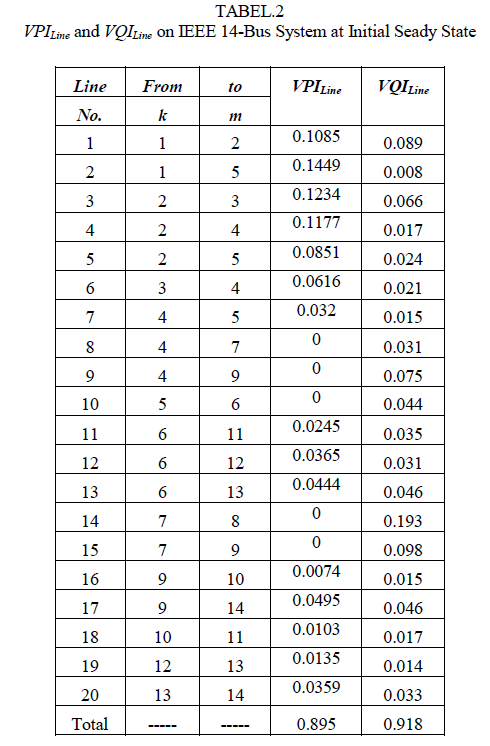 |
| Figure 6 illustrated the first loading scenario where the load powers were increased steady at all buses with identical loading rate k until the IEEE 14-bus system collapsed. The results showed that VPILine, VQILine,dV/dP and dV/dQ indices had an identical system voltage collapse prediction recording loading rate k =2.75. |
| At this point, all indices shared equal voltage stability margin. VPILine, VQILine indicated maximum real and reactive powers that can be transferred through the transmission lines for the system as a whole and also for every line while dV/dP and dV/dQ had voltage stability indications with limited information assigned to each line. VQILineindicated the outage of three lines due to their maximum reactive power limits at loading rate k = 2.44, 2.58and 2.67 respectively, while VPILine,dV/dP and dV/dQshowed no such outage indications. These line outages led to cascade voltage collapse. |
| B. IEEE 118-bus system: |
| This section exhibits an implementation of the proposed method, VPIbus,VQIbus, VPILine and VQILine on an IEEE 118-bus system to conduct line and bus voltage stability analysis. The proposed indices were compared with alternatives to verify their accuracy in predicting voltage collapse for large power systems. In this application, loads were remained constant and subjected to a gradual increase with a step of 0.01 units until the system collapsed. The first load scenario was considered here and power factor also remains constant. |
| 1. Loading scenario at bus system: |
| Figures (7) showed the performance of the proposed bus indices on IEEE 118-bus system and compared to VCPI and Modal analysis-dV/dP methods. In each of these subfigures, VPIbus and VQIbus are shown in sub-figures (a) and (c), while VCPI and dV/dP are shown in subfigures (b)and (d) respectively.Here, the first loading scenario was applied where the loads were increased simultaneously at all buses with identical loading rate k until the IEEE118-bus system collapsed. |
| The results showed that VPI bus, VQI bus, VCPI and dV/dP had very similar system voltage collapse prediction recorded at loading rate k =0.86. At this point, VPIbus, VQIbusand VCPI had exceeded their stability limits passing their unity while some of dV/dQcomponents went to zero and others approached infinity indicating its matrix reached singularity. All indices started with system initial condition at zero loading factor k and ended at the point of voltage collapse sharing equal system voltage stability margins. |
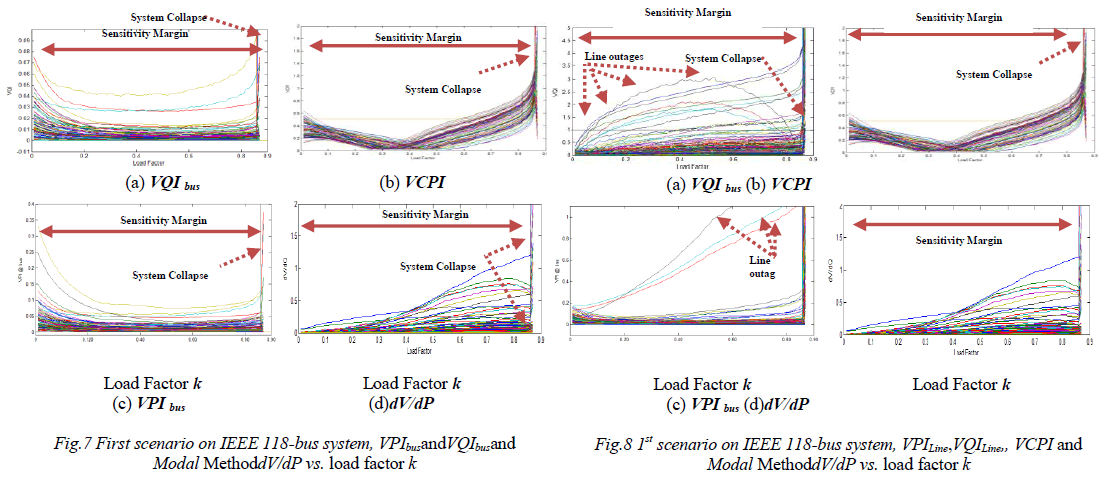 |
| 2. Loading scenario at line system: |
| Figures (8) show the performance of VPILine and VQILine on IEEE118-bus system and compared to VCPI and Modal analysis-dV/dP methods to measure their relative effectiveness and efficiency in predicting voltage collapse at large power system. In each of these subfigures, VPILine and VQILine are shown in sub-figures (a) and (c), while VCPI and dV/dP are shown in subfigures (b)and (d) respectively. |
| The procedure described above was repeated whereIEEE118-bus system was subjected to a gradual load increase at once until the system collapsed. The results showed the occurrence of voltage collapse at loading rate k =0.86, at whichVPILine, VQILineandVCPIindices passed their voltage stability limits while dV/dPwent to zero or approached to infinity. |
| Although the point of system collapse accurately projected by VCPI and dV/dQ methods, they showed no signs of line outages as VPILine and VQILine did. VQILine projected approximately 15 lines to be outage passing their maximum reactive power transfer limits dragging the entire system to collapse, when the cascade voltage collapse occurred. Three lines collapsed indicated by VPILine recorded in 0.44, 0.5 and 0.73 loading rate k respectively before system total collapse; indicating their maximum real power transfers reached to their limits. |
| Thus, VPILine and VQILine are able to provide maximum system loadability in both active and reactive powers not only for the system as a whole, but also for every line. With their simplicity, speeds of readability and knowing system loadability limits, operators may act fast to preserve system reliability not to prevent voltage instability. |
| 3. Indices Computation time: |
| The time consuming during voltage stability analysis is rather important particularly when power systems are operating daily or even hourly under stressed. As a result, the computation time of the proposed indices were demonstrate on IEEE 118-bus system and compared with alternative methods to show their effectiveness of executing voltage stability analysis. |
| Table 3 showed that the proposed indices had the lowest solution time to calculate and allocate voltage stability at each individual bus and/or line, recording 1.1166sec, which is probably the fast voltage stability analysis. The results showed that VQILine was the fastest index among the proposed indices recoding 1.1166sec while VQIbus was slowest in computation time estimated at 1.1166sec. Our results also indicated that VPIbus ,VQIbus,VPILine, andVQILine were still faster in producing voltage stability indications comparing to the alternative methods. Modal indices, for example, recorded the highest computation time estimated at 1.4635sec and 1.5154sec for dV/dQ and dV/dP respectively. |
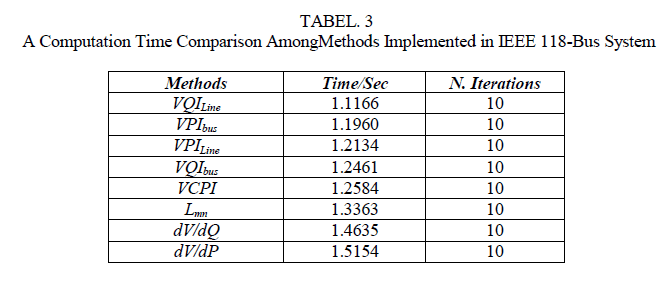 |
| C. Overall Results: |
| Overall, VPIbus, VQIbus VPILine and VQILine have very similar stability margins providing almost identical voltage collapse point for power system as a whole while they have the same voltage stability results comparing to modal analysis, Lmn,VCPI, and receiving-end voltage Vbus. The results also exhibit high voltage stability analysis with low computation time using VPIbus, VQIbus VPILine and VQILineindices generating accurate voltage stability indications and allocations with clear readability for each individual line and bus and also for entire power system. |
| VCPI and modal analysis are powerful approach conducting voltage stability analysis in bus system while line voltage stability is effectively conducted by Lmnmethod. However, modal indices are complex and consuming much calculation times to conduct voltage stability analysis. Their stability indications are based on Jacobian sensitivities which are not easy to extract voltage stability at each individual bus or system line. For a system with several thousand buses it is impractical to calculate all of eigenvalues even calculating the minim eigenvalues of Jris not sufficient; because there is more than one weak mode associated withdifferent part of the system. Although VCPI has advantages of lowering analysis computation time with good voltage stability indications for ever bus, its information is based on voltage ratios with no sing of remedial actions. |
| VPIbus and VQIbus generate indications of voltage stability for each power system bus while VPILine and VQILine produce voltage stability indications at each individual line. Voltage collapse are accurately predicted by VPIbus , VQIbus, VPILine and VQILine comparing to alternative methods estimating voltage stability margins for each power system bus and line; and indicating maximum active and reactive power transfers through transmission systems. |
| bus and line; and indicating maximum active and reactive power transfers through transmission systems. VPIbusandVQIbus study the load and generation dynamics while VPILineandVQILine study transmission lines stress and outage. The synchronism of generators and loads might be predicted or detected using these indices while other methods such VCPIshow no signs of line outages during load increase. |
| The proposed indices produce more voltage stability indicationsonce a power system subjected to an unexpected increase of load components. Limited power transfers and shortage in supplying reactive power demands may cause a partial or total system breakdown. Our results also show that the occurrences of voltage collapse take faster rates when a system subjected to an increase of active and reactive load components. Although those indices are valid for the linearized model as dynamic analysis is preferred by some utilities, the proposed indices can be applied at points in timein a dynamic simulation and can be also implemented easily in on-line voltage stability applications. |
| Thus, the proposed indices,VPIbus ,VQIbus, VPILine and VQILineare superior in their simplicity, accuracy, speed calculations and direct VQ and VP associations indicating a powerful tool to conduct a static voltage stability analysis and predicts precisely the point of voltage collapse. They also are capable of identifying the weaken buses and which area are involved with. With this simplicity, speeds of readability and knowing system maximizing power transfers, operators may act faster than before particularly when the system subjected to a sudden disturbance; not only to prevent voltage instability, but also to improve system stability ensuring its security. |
V. CONCLUSION: |
| This paper presented a new approach of analysing voltage stability in power systems. Voltage stability in transmission lines and power system buses are carefully analysed as to prevent line outages and/or to avoid partial or total system voltage collapse. Four indices are proposed; VPIbus and VQIbus for voltage stability analysis at system buses studying the dynamics of loads and generatorswhile VPILine and VQILineare for line voltage stability analysisstudying transmission lines stress and outages. |
| VPIbus and VQIbus generate indications of voltage stability for each power system bus while VPILine and VQILine produce voltage stability indications at each individual line. Voltage collapse are accurately predicted by VPIbus , VQIbus, VPILine and VQILine comparing to the alternative methods estimating voltage stability margins for each power system bus and line; and indicating maximum active and reactive power transfers through transmission systems. In other words, the proposed indices indicate how far the bus and/or line are from their severe loading condition or outages. |
| The accuracy ofVPIbus ,VQIbus, VPILine and VQILine in conducting voltage stability analysis and theirestimation of voltage collapse were verified extensively, indicating that they have very similar system stability margins and voltage collapse detectioncomparing to alternative methods. Line outages are predicted by VPILine and VQILinecaused by either limited real power transfers or insufficient reactive power to support the required demand. |
| The results also show the proposed indices are superior to theirsimplicity, accuracy, speed calculations and direct VQ and VP associations indicating a powerful tool to conduct a static voltage stability analysis and predict precisely the point of voltage collapse. With this simplicity, speeds of readability and knowing system maximizing power transfers, operators may act faster than before particularly when the system subjected to a sudden disturbance; not only to prevent voltage instability, but also to improve system stability ensuring its security. |
References |
|